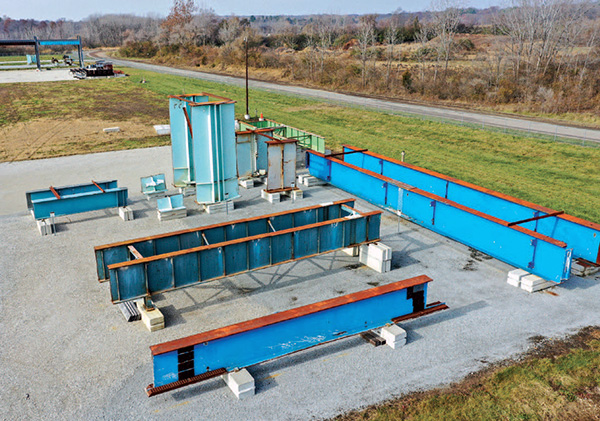New ideas from old structures
Engineers study, teach structural health at the Center for Aging Infrastructure

The Memorial Bridge connecting Washington, D.C., and Arlington, Virginia.
The Pensacola Bay Bridge in Florida.
New York’s Brooklyn Bridge.
These are just three of more than 47,000 bridges across the nation that are classed as structurally deficient, according to a 2019 report from the American Road & Transportation Builders Association. The average age of these structures is 62 years. Fully four out of 10 U.S. bridges need to be replaced or repaired, the report states.
Unique steel specimens
At Purdue University, transportation engineers learn to identify and prevent potential disasters caused by aging infrastructure — by educating students and practitioners and by developing cutting-edge inspection and monitoring techniques.
Purdue's Center for Aging Infrastructure (CAI), a 22-acre plot of ground nestled among farm fields south of campus, is home to dozens of steel infrastructure specimens that have been removed from their original locations and put on display. Visitors can walk around and examine numerous bridge components, including three full-scale bridges.
"No one else has assembled a set of specimens that can be used for training and research like this," says Robert Connor, center director and Jack and Kay Hockema Professor in Civil Engineering. "As far as we know, this is the only such place in the world."
In the coming months, Connor plans to install 600 feet of railroad track and working signals to further develop educational and research opportunities in support of the railway industry.
Unsurprisingly, the CAI is a magnet for civil engineering faculty and graduate students seeking to understand and prevent structural failure.

Steel bridge components on display at the 22-acre Center for Aging Infrastructure.
A hands-on test bed
One regular researcher at the CAI is Ayman Habib, the Thomas A. Page Professor of Civil Engineering. Habib co-directs the Civil Engineering Center for Applications of UAS for a Sustainable Environment (CE-CAUSE). The site serves as a base camp for his remote sensing research as he aims to improve the reliability of infrastructure inspections.
Using unmanned aerial systems (UAS) and ground vehicles, Habib and his team collect high-resolution remote sensing data by means of LiDAR and other specialized imaging techniques.
By utilizing technology to perform inspections, Habib says we can examine structures more frequently and more accurately. Machine-driven inspections are safer, too, eliminating the need for workers to hang from cherry pickers or operate in high-speed traffic zones.
"This site is unique to Purdue," Habib says. "It is uncommon for students to have access to the infrastructure like we have here at the CAI — and to have access to the latest data acquisition systems. Our students get firsthand experience in the real world process, from data acquisition to product delivery."
Habib's team employs remote sensing techniques that go beyond human vision. In addition to red-green-blue cameras and LiDAR imagery, he uses hyperspectral cameras to capture ultra-high resolution images of infrastructure components. "By looking over wavelengths invisible to the human eye, with very high spectral resolution, we can get much more information about corrosion, rust and fatigue," he says.

PhD candidate Radhika Ravi
Next generation researchers
Graduate researchers like Radhika Ravi, a second-year PhD candidate in civil engineering, help in two ways: They assist with data acquisition and processing, and they develop software and algorithms to analyze the data. Ravi first experienced the CAI as a master's student. "It was a huge place," she says. "I had to ask around my research group to know what it was about."
As part of Professor Habib's geomatics research group, she uses UAV and vehicle-mounted LiDAR to discover deflections in the CAI infrastructure, including those that might reveal the possibility of collapse.
"We drive around the area, get LiDAR data and process it — which gives us the 3D point cloud," she says. "And from that, we can extract different features or different traits of the infrastructure."
Ravi’s research focus is geomatics, working with LiDAR to extract information infrastructure along transportation corridors. "For people focused on structures, the CAI is a full-fledged place for getting a practical sense of what we study in theory."
A tenant of the CAI is the Steel Bridge Research, Inspection, Training and Engineering Center, known as S-BRITE. The group's mission is to ensure the nation's steel infrastructure remains safe and reliable.
After attending specialized S-BRITE training in bridge inspection, an individual from the Army Corps of Engineers commented that "you could spend 20 years inspecting bridges and never see all the details and forms of damage that you can examine firsthand when visiting the CAI."
Such sentiments gratify Connor, who understands that engineers learn by visual and tactile experience. "I could lecture all day, but when you can walk up to a specimen — see it and touch it — it just makes sense," he says.
